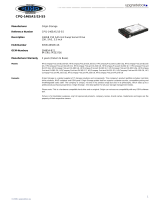
Integration Note
Help us improve our technical communication. Let us know what you think
about the technical information in this document. Your feedback is valuable
and will help us structure future communications. Please send your
comments to:
December 2000
13UK-1200A-WWEN
Prepared by OS Integration
Engineering
Compaq Computer Corporation
Contents
Executive Overview.....................3
PCI Bus Architecture
Terminology.................................4
PCI Hot Plug Terminology..........5
PCI System Overview..................5
PCI Architecture and Bridged
Controllers..................................6
PCI BIOS ...................................8
PCI Bus Numbering...................8
PCI BIOS Discovery...................8
Configuration Changes............11
Windows NT and PCI Bus
Numbering..................................11
PCI Bus Numbering and
Network Controllers..................11
Disk Renumbering....................12
Hardware, Software, and
Configuration Tools...................13
Compaq Servers and Option
Hardware .................................13
Planning a PCI System
Configuration.............................17
Before Modifying an Existing
System.....................................18
Planning the New
Configuration............................18
Step-By-Step Review...............19
PCI Test Configurations with
ProLiant Servers........................19
Configuration A, ProLiant
ML530......................................20
Configuration B, ProLiant
8000.........................................23
Configuration C, ProLiant
DL580 ......................................29
Compaq Support Software
and Utilities ..............................36
Additional Troubleshooting
Tips.............................................39
Summary....................................40
Appendices A-D.........................41
PCI Bus Numbering in a
Microsoft Windows NT
Environment
Abstract: Computing environments change rapidly to support
business requirements. Typical network PCI-based servers contain a
large number of expansion slots on multiple buses to allow for
system growth. This means that multiple network and disk
controllers of the same type may be installed in one server, with the
intent that each installed controller supports a separate unique
function. This can make it difficult to understand the physical and
logical implications of PCI bus numbering.
This document provides information to help systems engineering
professionals understand how Microsoft Windows NT handles PCI
bus numbering when controllers are physically added, moved, or
removed from a server configuration. This document also includes
ideas and suggestions that can help systems professionals avoid
network downtime due to configuration changes.
IMPORTANT: During the development of Microsoft Windows
2000, Compaq and Microsoft worked closely together effectively
implementing Windows 2000 on Compaq hardware. Through this
partnership, device detection improved, eliminating PCI bus
numbering issues in the Windows 2000 environment. Windows 2000
checks and resets registry settings automatically, unlike its
predecessor that does not reset the registry settings after discovering
unbound devices.
The following documents were either used as references to produce
this white paper or are mentioned as recommended related reading
material:
• PCI System Architecture, Third Edition, MindShare, Inc. Tom
Shanley and Don Anderson, November, 1995.
• PCI Bus Balancing and Optimization on Compaq ProLiant
Servers, March, 1998 – Doc ID ECG073/0398.
• Where Do I Plug the Cable? Solving the Logical-Physical Slot
Numbering Problem, December 1996 – Doc ID 209A/1296.
• Deploying PCI Hot Plug on Compaq
Servers in a Microsoft
Windows NT
Environment, July 1997 - Doc ID 064A/0797.
























